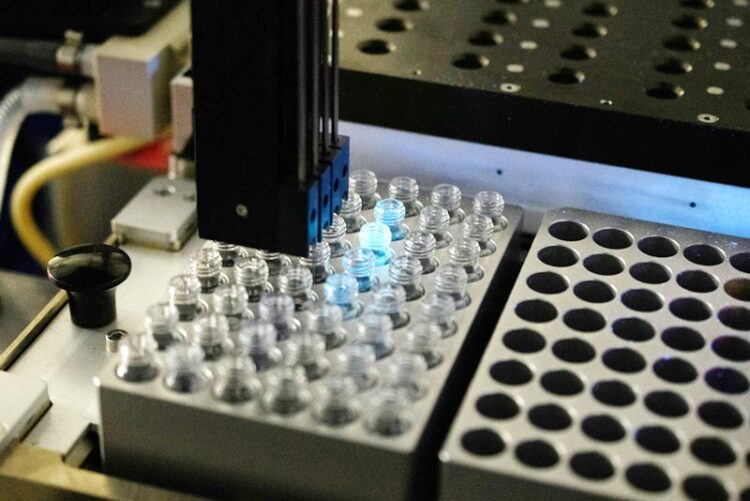Robots and A.I. team up to discover highly selective catalysts

Close up of the semi-automated synthesis robot used to generate training data (Photo: ICReDD)
Researchers used a chemical synthesis robot and computationally cost effective A.I. model to successfully predict and validate highly selective catalysts.
Artificial intelligence (A.I.) has made headlines recently with the advent of ChatGPT’s language processing capabilities. Creating a similarly powerful tool for chemical reaction design remains a significant challenge, especially for complex catalytic reactions. To help address this challenge, researchers at the Institute for Chemical Reaction Design and Discovery and the Max Planck Institut für Kohlenforschung have demonstrated a machine learning method that utilizes advanced yet efficient 2D chemical descriptors to accurately predict highly selective asymmetric catalysts—without the need for quantum chemical computations.
“There have been several advanced technologies which can “predict” catalyst structures, but those methods often required large investments of calculation resources and time; yet their accuracy was still limited,” said joint first author Nobuya Tsuji. “In this project, we have developed a predictive model which you can run even with an everyday laptop PC.”
For a computer to learn chemical information, molecules are usually represented as a collection of descriptors, which often consist of small parts, or fragments, of those molecules. These are easier for A.I. to process and can be arranged and rearranged to construct different molecules, much like Lego pieces can be arranged and connected in different ways to construct different structures.
However, computationally cheaper 2D descriptors have struggled to accurately represent complex catalyst structures, leading to inaccurate predictions. To improve this issue, researchers developed new Circular Substructure (CircuS) 2D descriptors that explicitly represent cyclic and branched hydrocarbon structures, which are common in catalysis. Training data for the A.I. was obtained through experiments via a streamlined, semi-automatic process utilizing a synthesis robot. This experimental data was then converted into descriptors and used to train the A.I. model.
Researchers used the fully trained model to virtually test 190 catalysts not part of the training data. In this set, the A.I. model was able to predict highly selective catalysts after only having been trained on the data of catalysts with moderate selectivity, showing an ability to extrapolate beyond the training data. The catalyst predicted to have the highest selectivity was then tested experimentally, exhibiting a selectivity nearly identical to that predicted by the A.I. model. Obtaining high selectivity is especially crucial for the design of new medicines, and this technique provides chemists with a powerful framework for optimizing selectivity that is efficient in both computational and labor cost.
“Often, to predict new selective catalysts chemists would use models based on quantum chemical calculations. However, such models are computationally costly, and when the number of compounds and the size of molecules increases, their application becomes limited,” commented joint first author Pavel Sidorov. “Models based on 2D structures are much cheaper and therefore can process hundreds and thousands of molecules in seconds. This allows chemists to filter out the compounds they may not be interested in much more quickly.”
Journal: Angewandte Chemie International Edition
DOI: 10.1002/anie.202218659
Method of Research: Experimental study
Subject of Research: Not applicable
Article Title: Predicting highly enantioselective catalysts using tunable fragment descriptors
Article Publication Date: 23-Jan-2023
Media Contacts
Sohail Keegan Pinto
Hokkaido University
en-press@general.hokudai.ac.jp
Office: +81-11-706-2186
@HokkaidoUni
Collin Stecker
Institute for Chemical Reaction Design and Discovery (WPI-ICReDD), Hokkaido University
public_relations@icredd.hokudai.ac.jp
Office: +81-11-706-9646
@ICReDDConnect (Twitter)
All latest news from the category: Life Sciences and Chemistry
Articles and reports from the Life Sciences and chemistry area deal with applied and basic research into modern biology, chemistry and human medicine.
Valuable information can be found on a range of life sciences fields including bacteriology, biochemistry, bionics, bioinformatics, biophysics, biotechnology, genetics, geobotany, human biology, marine biology, microbiology, molecular biology, cellular biology, zoology, bioinorganic chemistry, microchemistry and environmental chemistry.
Newest articles

Innovative 3D printed scaffolds offer new hope for bone healing
Researchers at the Institute for Bioengineering of Catalonia have developed novel 3D printed PLA-CaP scaffolds that promote blood vessel formation, ensuring better healing and regeneration of bone tissue. Bone is…

The surprising role of gut infection in Alzheimer’s disease
ASU- and Banner Alzheimer’s Institute-led study implicates link between a common virus and the disease, which travels from the gut to the brain and may be a target for antiviral…

Molecular gardening: New enzymes discovered for protein modification pruning
How deubiquitinases USP53 and USP54 cleave long polyubiquitin chains and how the former is linked to liver disease in children. Deubiquitinases (DUBs) are enzymes used by cells to trim protein…



